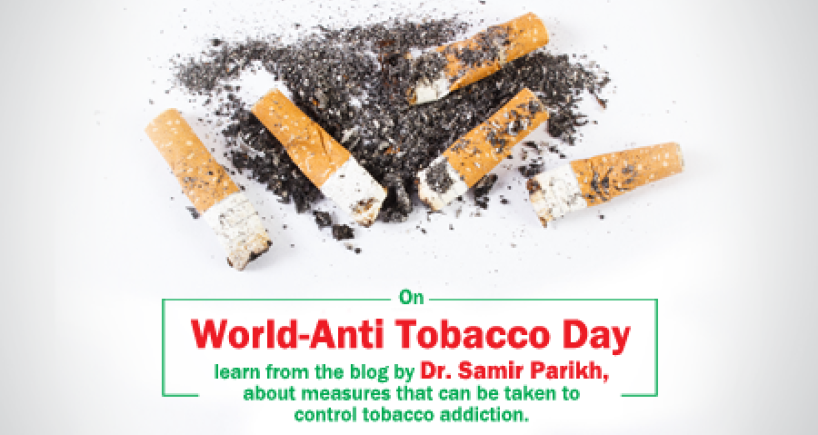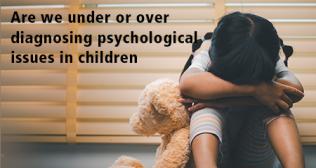
World Anti-Tobacco Day

It is alarming to not the rate of increasing prevalence of substance use today, especially for the youth. Alcohol and drug addiction is a common challenge among adolescents that has far reaching negative impacts on their physical, emotional and psychological development, even leading to numerous mental health disorders. And it is saddening to observe such an increase and attraction towards tobacco use, despite its well-known hazards. The consumption of substances like alcohol, nicotine, caffeine, or other drugs are known to be associated with high levels of risks, related to physical and mental health disorders, for not just the consumers, but for those around them as well On the occasion of World Anti-Tobacco Day, let us ponder over what can be done at our end to bring about a change for a preventive approach towards such behaviour.
Signs of dependence
First and foremost, it is important for all of us to be aware of the warning signs of a dependence of the substance use.
- Physical, behavioral and psychological withdrawal symptoms – the individual typically begins to increase smoking in efforts to escape from experiencing these withdrawal symptoms, which could include symptoms like sweating, tremors, nausea, or sleeplessness due to suddenly stopping the consumption of tobacco
- The individual’s tolerance level goes up and he or she needs more and more of tobacco to fulfill his or her needs of calmness or any other valuable need that is being fulfilled by the tobacco in the eyes of the user. This happens as the person’s reaction, to the same quantity of tobacco gets reduced over a prolonged use, thereby making him or her progressively increase the quantity of consumption. Such a tolerance could be both physiological as well as psychological, leading to increased cravings for smoking.
- All of the individual’s time is spent preoccupied with either procuring the tobacco or smoking it. Due to this, there is a significant reduction in other adaptive and occupational activities.
- There is a significant loss of control and the individual feels compelled to smoke ‘despite himself’ and despite being aware of the negative consequences of consuming it, not just on the self but also on others around the person.
The role of the media and peers
In today’s world, the outreaching influence of the media cannot be undermined in having a significant contribution towards the attraction of the youth towards risk-taking behavior like smoking. It is not uncommon for advertising campaigns to be targeting the adolescents and teenage section of the population, as the young minds are more vulnerable to observing and learning from their surroundings. And therefore, the importance of media literacy needs to be highlighted amongst the youth today. Media literacy is broadly the ability to critically understand the messages the media shows us, in order for us to use it effectively to make the right decisions. It encourages students to think about how the media co-constructs reality, who it benefits and how, how it captivates us and how to break the stereotypes propagated therein.
In addition, the role of the peers cannot be undermined, as adolescence is a period of development wherein the peers are given the utmost importance in comparison to almost all other agencies of control. And such an attraction towards ‘being cool’, or a pressure to be able to ‘fit in’ with the others can often serve as a pushing force towards various risk taking behavior despite being aware of the consequences. The teen years are a critical period of development, and adolescents are given to be experimental with many risk taking behaviors including the use and abuse of drugs and alcohol. Within this phase, the youngsters have a simple curiosity, and are keen to experiment all options as they have a need to explore the consequences for themselves. In the process, an addictive behaviour is likely to gradually increase, as there is a very thin line between casual use and drug abuse.
Underlying psychological factors
Further, often youngsters, or even adults’ need to be attracted to smoking or other forms of substance use could stem from an underlying psychological factor or personality predisposition which increases their vulnerability towards such behaviours. Such an addictive behaviour could actually begin to fulfill a valuable need in the eyes of the use, which could be anything from mood elevation, to pain relief, either physical or emotional. In addition, resorting to such a behaviour could be a faulty coping mechanism for the person to be able to deal with the feelings of loneliness, depression, low self-esteem, stress or anxiety, or to cope with family related problems or stressors, or any other mental health related disorder like psychosis as well.
Moreover, individuals who have aggressive or disruptive tendencies, or personality traits which predispose them towards such risk taking attitudes could have manifestations in the form of resorting to such adddicitve behaviours.
Role of parents and family members
It is essential firstly for parents and family members to be educated with adequate and complete information regarding the nature of substance use. Many people may blame the adolescent for falling prey to such a habit, considering drug addiction to be a voluntary behavior or a character flaw. It is necessary to be able to bust such myths and to ensure that drug addiction be understood as a disease, which can be treated.
In their efforts to help the adolescent overcome such addictions, the parent or the family member must ensure that they develop a trusting rapport with the adolescent. The family members must not be patronizing towards them, instead being supportive and engage with the adolescents, encouraging them to seek professional help. Moreover, it is vital that the parents do not assume a penalizing role, instead involving the adolescent in the decision making process, providing a support system, and simultaneously making the adolescent take on the responsibility and commitment towards seeking help.
The Way Forward
It is important to remember that all substance use disorders, including smoking, are medical conditions, requiring adequate professional interventions, including a combination of medications and psychotherapy. Professional help is irreplaceable, and addictive behaviours do not change abruptly, but through a series of stages. Support and motivation are a very important part of a successful recovering addict, and once a person has developed a dependence on a substance, there almost always remains a danger of relapse. Counseling in such a scenario for the recovering addict as well as the family is very useful.
Therefore, in order to ensure an adequate management of such a battle against tobacco use, it is the responsibility not just of the healthcare providers, but for all of us to join hands and create an adequate awareness, as it is essential firstly for parents and family members to be educated with adequate and complete information regarding the nature of tobacco use.
In addition, it is the need of the hour to strongly advocate the preventive as well as curative aspects of mental health. As health practitioners, we need to promote private-public partnerships, in order to ensure that we come together to work towards targeting the very grass-root levels, and help make a difference in the community at large. At the same time, we need to promote an adequate training and empowerment of parents, teachers, social workers, staff and all those first-line workers actively engaging with children and adolescents, to be able to have the earliest identification as well as timely interventions for the young minds who shall form the future of our country.
See doctor Samir Parikh's profile here
Categories
Clear allMeet the doctor

- Mental Health and Behavioural Sciences | Mental Health and Behavioural Sciences | Psychiatry | Clinical Psychology
-
21 Years
-
900



















